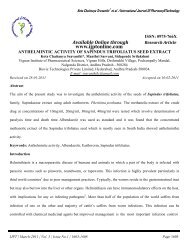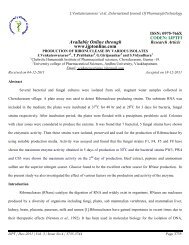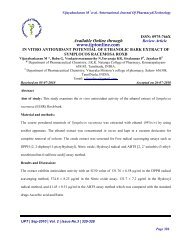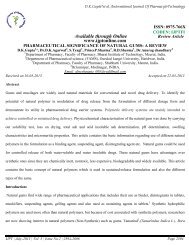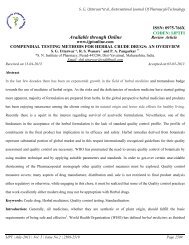Available Online through - International Journal of Pharmacy and ...
Available Online through - International Journal of Pharmacy and ...
Available Online through - International Journal of Pharmacy and ...
You also want an ePaper? Increase the reach of your titles
YUMPU automatically turns print PDFs into web optimized ePapers that Google loves.
Jyothi.V * et al. /<strong>International</strong> <strong>Journal</strong> Of <strong>Pharmacy</strong> & Technology<br />
ISSN: 0975-766X<br />
<strong>Available</strong> <strong>Online</strong> <strong>through</strong><br />
Review Article<br />
www.ijptonline.com<br />
THE PHARMACOGNOSTIC, PHYTOCHEMICAL AND PHARMACOLOGICAL<br />
PROFILE OF LUFFA ACUTANGULA<br />
Jyothi.V*, Srinath Ambati <strong>and</strong> Asha Jyothi .V<br />
Vignan Institute <strong>of</strong> Pharmaceutical Sciences, Deshmukhi, Nalgonda, Andhra Pradesh, India.<br />
E-mail: jyothi.vonguru@gmail.com<br />
Received on 15-10-2010 Accepted on 10-11-2010<br />
ABSTRACT:<br />
Many neutraceuticals are not very popular but they are having great potential to produce certain pharmacological<br />
properties. Study <strong>of</strong> evidence based scientific reportings can become the foundation for further research keeping in<br />
view <strong>of</strong> the phytochemical constituents <strong>and</strong> their pharmacological responses. Luffa acutangula is one such plant<br />
which has not grabbed considerable attention .This article was designed with an intention to provide complete<br />
review <strong>of</strong> its pharmacognostic details, phytochemical constituents <strong>and</strong> pharmacological activities.<br />
KEYWORDS: Luffa acutangula, Hepatoprotective activity.<br />
INTRODUCTION:<br />
Luffa acutangula (Family: Cucurbitaceae) is commonly known as Ridge gourd. It is a widely growing vegetative<br />
climber. The fruits are base ball club shaped. Various pharmacological activities include hepatoprotective activity 1 ,<br />
antidiabetic activity 2 , antioxidant activity 3 , fungistatic property 4 , CNS depressant activity 5<br />
etc. Its chemical<br />
constituents were found to be carbohydrates, carotene, fat, protein, phytin, aminoacids, alanine, arginine, cystine,<br />
glutamicacid, glycine, hydroxyproline, leucine, lectin, serine, tryptophan, pipecolic acid 6-8 . It has a good<br />
hepatoprotective potential <strong>and</strong> supports the claims made in folklore medicine. Though many activities <strong>of</strong><br />
L.acutangula were reported, its potential as a pharmacological aid has to be still explored.<br />
IJPT | Dec-2010 | Vol. 2 | Issue No.4 | 512- 524<br />
Page 512
ANCIENT LITERATURE:<br />
Jyothi.V * et al. /<strong>International</strong> <strong>Journal</strong> Of <strong>Pharmacy</strong> & Technology<br />
Ancient literature revealed that the plant is significantly used as abortifacient <strong>and</strong> antifungal agent. 9<br />
PHARMACOGNOSY:<br />
Taxonomical classification:<br />
Kingdom :<br />
Plantae<br />
Division : Magnoliophyta<br />
Class : Magnoliopsida<br />
Order : Cucurbitales<br />
Family : Cucurbitaceae<br />
Genus : Luffa<br />
Species : acutangula<br />
Othernames:<br />
Sanskrit:<br />
Hindi:<br />
Punjabi:<br />
Gantali, Kosataki, Ksweda, Mridangaphalika, Sutikta.<br />
Jhimani, Karvitarui, Karvituri, Sankirah, Rantorai.<br />
Jhinga,Shirola.<br />
English: Ridge gourd, Angled lo<strong>of</strong>ah, Chinese okra, Dish-clothgourd, Ribbed lo<strong>of</strong>ah, Silk gourd, Silky gourd,<br />
Sinkwa towelsponge, Sinqua melon,Vegetable sponge.<br />
Bengali:<br />
Titotorai, Titojhinga, Titodhundal, Jhinga, Ghoshalata.<br />
Kannada: Kahire, Kahi Heere, Naaga daali balli.<br />
Malayalam: Athanga.<br />
Marathi:<br />
Divali, Kadudodaki, Kadushirali, Kaduturai, Ranturai, Kadudod-ka, Dadudodaka.<br />
Tamil: Itukari, Itukarikkoti, Kacappi, Kacappuppirkku, Kaccam, Kaippuppirkku, Karniti, Karnitikkoti,<br />
Katiyavisava, Kirutacittirar, Kirutavetanai.<br />
IJPT | Dec-2010 | Vol. 2 | Issue No.4 | 512- 524<br />
Page 513
Telugu:<br />
Jyothi.V * et al. /<strong>International</strong> <strong>Journal</strong> Of <strong>Pharmacy</strong> & Technology<br />
Adavibira, Chedubira, Sendubirai, Verribira, Adivibeera, Verri beera, Chedu beera, Adavi beera, Chathi<br />
beera.<br />
DESCRIPTION:<br />
Luffa acutangula is a large monoious climber. It has 5 angled glabrous stem <strong>and</strong> 3-fid tendril. Leaves <strong>of</strong> this plant<br />
are orbicular, pale green in colour 15-20 cm across <strong>and</strong> palmately 5-7 angled or lobed. Veins <strong>and</strong> veinlets are<br />
prominent.<br />
Figure:1 Leaves <strong>of</strong> L.acutangula<br />
Figure:2 L.acutangula fruit & seed<br />
Fruits <strong>of</strong> Luffa acutangula are obovate, pale yellowish brown in colour, 4-10 cm long, 2-4 cm broad <strong>and</strong> outer<br />
surface being covered with 8-10 prominent longitudinal ribs. The fruits is divided into 3 chambers. The inner part is<br />
fibrous <strong>and</strong> easily detachable as a whole from the outer part. Taste is bitter. Transverse section <strong>through</strong> a rib shows<br />
a single layer <strong>of</strong> papillose epidermis covered with thick striated cuticle. It is followed by 4-6 layers <strong>of</strong><br />
parenchymatous cells.<br />
Distribution: Luffa acutangula is pantropical <strong>and</strong> cultivated <strong>through</strong>out India.<br />
IJPT | Dec-2010 | Vol. 2 | Issue No.4 | 512- 524<br />
Page 514
Habit: Herb.<br />
Jyothi.V * et al. /<strong>International</strong> <strong>Journal</strong> Of <strong>Pharmacy</strong> & Technology<br />
Propagation: Propagation <strong>of</strong> L.acutangula is by seeds.<br />
Native range: India <strong>and</strong> naturalised tropic <strong>and</strong> subtropics.<br />
Cultivation: Luffa acutangula can grow in all type <strong>of</strong> soils <strong>and</strong> can be grown in summer or in rainy season. Seeds<br />
can accordingly be sown either in february-march or june-july.<br />
Table No-1: Macroscopy <strong>of</strong> luffa acutangula 24<br />
S.no<br />
PART OF THE<br />
PLANT<br />
LENGTH THICKNESS COLOUR SHAPE<br />
1 Root 8-12 cm 0.5-0.7 cm Yellowish brown Cylindrical.<br />
2 Stem - 0.2-0.4 cm Brownish yellow Angular.<br />
3 Leaf:<br />
Petiole<br />
Lamina<br />
3-8 cm<br />
6-9 cm<br />
-<br />
6-9 cm<br />
Brownish yellow<br />
Light green<br />
Angular, wrinkled.<br />
Curled,<br />
corrugated.<br />
4 Flower:<br />
Male flower<br />
Female flower<br />
1.3 cm<br />
-<br />
-<br />
-<br />
Light greenish yellow<br />
Yellow<br />
-<br />
-<br />
5 Fruit 9-12 cm 2-4 cm Pale yellowish brown Cylindrical / Club<br />
6 Seed 0.6-0.8 cm 0.5-0.6 cm Black Ovoid / Oblong<br />
IJPT | Dec-2010 | Vol. 2 | Issue No.4 | 512- 524<br />
Page 515
Jyothi.V * et al. /<strong>International</strong> <strong>Journal</strong> Of <strong>Pharmacy</strong> & Technology<br />
Table No-2: Microscopy <strong>of</strong> Luffa acutangula 24<br />
S.no<br />
PART OF<br />
THE<br />
PLANT<br />
CELL CONSTITUENTS<br />
1 Root Outer cork cells, secondary cortex containing disintegrated <strong>and</strong> few lignified cells,<br />
lignified stone cells, secondary phloem, secondary xylem tissues containing ray cells,<br />
simple pitted xylem vessel, oval starch grains, distinct hilum in secondary cortex.<br />
2 Stem Single layer epidermis covered by cuticle, cortex containing collenchymal <strong>and</strong> few<br />
lignified cells, ground tissue made <strong>of</strong> parenchyma containing open, bicollateral, conjoint,<br />
endarch vascular bundles, secondary phloem <strong>and</strong> secondary xylem, bordered pitted xylem<br />
vessel, starch grains, distinct hilum.<br />
3 Leaf:<br />
Petole<br />
Lamina<br />
Single layer epidermis covered by thick cuticle, parenchymatous secondary tissue, ground<br />
tissue containing bicollateral vascular bundles.<br />
Single layered epidermis on both surfaces, mesophyll differentiated into palisade <strong>and</strong><br />
spongy parenchyma, vascular bundles are bicollateral, stomata are anomocytic.<br />
4 Fruit Epicarp covered by thick cuticle is made up <strong>of</strong> single layered papillose epidermis,<br />
parenchyamatous cells, stone cells, parenchymatous mesocarp having bicollateral vascular<br />
bundles.<br />
5 Seed Single layer <strong>of</strong> thick-walled sclerenchymatous testa ,tegmen made up <strong>of</strong> polygonal<br />
parenchyamatous cells, endosperm made up <strong>of</strong> parenchymatous cells.<br />
St<strong>and</strong>ards:<br />
Studies conducted on identity, purity <strong>and</strong> strength <strong>of</strong> Luffa acutangula revealed that it contains 24<br />
• Total ash content not more than 16%,<br />
• Foreign matter not more than 2%,<br />
• Acid-insoluble ash not more than 4%,<br />
• Water soluble extract not more than 13%<br />
•<br />
Alcohol soluble extract not more than 6%.<br />
IJPT | Dec-2010 | Vol. 2 | Issue No.4 | 512- 524<br />
Page 516
PHYTOCHEMICAL CONSTITUENTS:<br />
Jyothi.V * et al. /<strong>International</strong> <strong>Journal</strong> Of <strong>Pharmacy</strong> & Technology<br />
Chemical constituents <strong>of</strong> Luffa acutangula mainly include carbohydrates, carotene 19 , fat, protein, phytin,<br />
aminoacids, alanine, arginine, cystine, glutamicacid, glycine, hydroxyproline, leucine, serine,<br />
tryptophan,<br />
pipecolic acid 8 , flavonoids 20 , saponins 21. The fruit contains an amorphous bitter principle, luffeine. The seeds<br />
contain a fixed oil which consists <strong>of</strong> the glycerides <strong>of</strong> palmitic, stearic, <strong>and</strong> myristic acids. 22<br />
Lectin specific for chito-oligosaccharides was isolated from Luffa acutangula <strong>and</strong> has been purifed to<br />
homogenity by affinity chromatography <strong>and</strong> its macromolecular properties <strong>and</strong> combining affinity with different<br />
sugars was studied. The studies revealed that lectin has a molecular weight <strong>of</strong> 48,000 <strong>and</strong> stokes radius <strong>of</strong> 2.9 nm.<br />
When sodium dodecyl sulfate-polyacrylamide gel electophoresis was performed, only single b<strong>and</strong> corresponding to<br />
molecular weight <strong>of</strong> 24,000 was observed both in the presence as well as absence <strong>of</strong> 2-mercaptoethanol. The<br />
subunits in this dimeric lectin are therefore held by non-covalent interactions alone. The lectin is not a glycoprotein<br />
<strong>and</strong> circular dichroism spectral studies indicate that this lectin has 31% α-helix <strong>and</strong> no ß-sheet. The lectin is found<br />
to bind specifically to chito oligosaccharides <strong>and</strong> the affinity <strong>of</strong> the lectin increases with increasing oligosaccharide<br />
chain length as monitored by near ultra-violet circular dichroism <strong>and</strong> intrinsic fluorescence titration. The<br />
thermodynamic data revealed that binding site in lectin accommodates a tetrasaccharide <strong>and</strong> the values <strong>of</strong> ∆G, ∆Η<br />
<strong>and</strong> ∆S for the binding process showed a pronounced dependence on the size <strong>of</strong> the oligosaccharide. 7<br />
A chito oligosaccharide specific lectin (Luffa acutangula agglutinin) has been purified from the exudate<br />
<strong>of</strong> ridge gourd fruits by affinity chromatography on soybean agglutinin glycopeptides coupled to Sepharose-6B.<br />
The affinity purified lectin was found homogeneous by polyacrylamide gel electrophoresis. Based on the<br />
thermodynamic data, blue shifts <strong>and</strong> fluorescence enhancement, spatial orientation <strong>of</strong> chito oligosaccharides in the<br />
combining site <strong>of</strong> the lectin were studied. 10 Luffangulin, a novel ribosome inactivating peptide with an N-terminal<br />
sequence, was isolated from seeds <strong>of</strong> Luffa acutangula. The 5.6 kDa-peptide designated luffangulin inhibited cellfree<br />
translation with an IC 50 <strong>of</strong> 3.5 nM but lacked inhibitory activity toward HIV-1 reverse transcriptase. 12<br />
IJPT | Dec-2010 | Vol. 2 | Issue No.4 | 512- 524<br />
Page 517
Jyothi.V * et al. /<strong>International</strong> <strong>Journal</strong> Of <strong>Pharmacy</strong> & Technology<br />
A bitter principle, Cucurbitacin B, an acid sapogenin, oleanolic acid were isolated from the seeds <strong>of</strong> Luffa<br />
acutangula. 15<br />
The study <strong>of</strong> nutritional <strong>and</strong> oil characteristerics <strong>of</strong> the Luffa acutangula seeds showed that it has Iodine<br />
value, saponification value <strong>and</strong> acid value as 99.5, 190.8 <strong>and</strong> 10.5 respectively. The maximum melting <strong>and</strong> freezing<br />
points were found to be -3°C <strong>and</strong> -10°C respectively. 14<br />
Table No-3: Phytochemical constituents in each part <strong>of</strong> Luffa acutangula 17<br />
S.no Fruit Seed Cotyledons Callus<br />
1 Moisture<br />
(94.71%).<br />
2 Protein<br />
(1.077%).<br />
3 Alanine<br />
(0.313%).<br />
4 Arginine<br />
(0.114%).<br />
5 Aspartic acid<br />
(3.383%).<br />
6 Glycine<br />
(0.457%).<br />
7 Glutamic acid<br />
(1.0%).<br />
8 Histidine<br />
(0.203%).<br />
9 Isoleucine<br />
(0.295%).<br />
10 Leucine<br />
(0.709%).<br />
11 Lysine<br />
(0.159%).<br />
12 Phenylalanine<br />
(0.315%).<br />
13 Proline<br />
(0.349%).<br />
14 Serine<br />
(0.856%).<br />
15 Thronine<br />
(0.419%).<br />
16 Tyrosine<br />
(0.181%).<br />
17 Valine<br />
(0.524%).<br />
Fatty oil<br />
(28.5%).<br />
Total lipids<br />
(21.6%).<br />
Total lipids (2.6%).<br />
Lauric acid Unsaturated fatty Unsaturated fatty acids<br />
(1.78%).<br />
acids (68.63%). (28.80%).<br />
Myristic acid Saturated fatty acids Saturated fatty acids<br />
(9.84%).<br />
(31.37%).<br />
(71.20%).<br />
Palmitic acid Lauric acid. Lauric acid (4.54%).<br />
(23.09%).<br />
Stearic acid Myristic acid. Myristic acid (6.94%).<br />
(24.2%).<br />
Oleic acid Palmitic acid Palmitic acid (53.61%).<br />
(1.48%).<br />
(21.23%).<br />
Linoleic acid Stearic acid<br />
Stearic acid (6.11%).<br />
(33.56%). (10.14%).<br />
Trypsin inhibitors. Oleic acid<br />
Oleic acid (3.33%).<br />
(28.42%).<br />
- Linoleic acid Linoleic acid (8.43%).<br />
(40.21%).<br />
- Linolenic acid. Linolenic acid (17.04%).<br />
- - -<br />
- - -<br />
- - -<br />
- - -<br />
- - -<br />
- - -<br />
- - -<br />
IJPT | Dec-2010 | Vol. 2 | Issue No.4 | 512- 524<br />
Page 518
NUTRITIONAL COMPOSITION:<br />
Jyothi.V * et al. /<strong>International</strong> <strong>Journal</strong> Of <strong>Pharmacy</strong> & Technology<br />
The seeds <strong>of</strong> Luffa acutangula were studied for potential nutritional <strong>and</strong> oil characteristics. The fatty acid<br />
pr<strong>of</strong>ile indicates that the glycerides <strong>of</strong> oleic <strong>and</strong> linoleic acid constitute 68% <strong>of</strong> the total kernel oil. The seeds were<br />
also found to be a good source <strong>of</strong> certain amino acids, phosphorous, iron <strong>and</strong> magnesium. 14<br />
ETHANOMEDICAL PROPERTIES:<br />
The ethano medico botanical survey <strong>of</strong> the hilly areas in Maharshtra revealed that fruits <strong>of</strong> Luffa acutangula<br />
are used to protect from jaundice when taken in the form <strong>of</strong> very fine powder <strong>through</strong> nose. 19<br />
PHARMACOLOGICAL STUDIES:<br />
Hepatoprotective activity:<br />
Hydroalcoholic extract <strong>of</strong> Luffa acutangula (HAELA) was tested for hepatoprotective activity. St<strong>and</strong>ard<br />
drug used was silymarin. HAELA showed significant hepatoprotection against CCl 4 <strong>and</strong> rifampicin induced<br />
hepatotoxicity in rats. Hepatoprotective acton <strong>of</strong> HAELA was due to the decreased levels <strong>of</strong> serum marker<br />
enzymes(AST,ALT,ALP <strong>and</strong> LDH) <strong>and</strong> increased total protein including the improvement in histoarchitecture <strong>of</strong><br />
liver cells <strong>of</strong> the treated groups as compared to the control group. HAELA also showed significant decrease in<br />
malondialdehyde (MDA) formation, increased activity <strong>of</strong> non-enzymatic intracellular antioxidant, glutathoine <strong>and</strong><br />
enzymatic antioxidants, catalase <strong>and</strong> superoxide dismutase. Results <strong>of</strong> this study demonstrated that endogenous<br />
antioxidants <strong>and</strong> inhibition <strong>of</strong> lipid peroxidation <strong>of</strong> membrane contibute to hepatoprotective activity <strong>of</strong><br />
hydroalcoholic extract <strong>of</strong> L.acutangula. 1<br />
Investigations were made for hepatoprotective activity <strong>of</strong> saponin fraction <strong>of</strong> Luffa acutangula seeds in liver<br />
fibrocytic rat-induced with CCl 4 male Wistar rats were divided into six groups consisting <strong>of</strong> normal group, control<br />
group, comparator group <strong>and</strong> three test groups(given saponin fraction <strong>of</strong> Luffa acutangula). The study concluded<br />
that administration <strong>of</strong> saponin fraction at dose 10 mg/kg bw twice a week, 20 mg/kg bw twice a week <strong>and</strong> 20<br />
mg/kg bw once daily showed hepatoprotective activity <strong>and</strong> the highest effect was showed at a dose <strong>of</strong> 20 mg/kg bw<br />
once daily.<br />
IJPT | Dec-2010 | Vol. 2 | Issue No.4 | 512- 524<br />
Page 519
Developmental toxicity:<br />
Jyothi.V * et al. /<strong>International</strong> <strong>Journal</strong> Of <strong>Pharmacy</strong> & Technology<br />
The tea made from Luffa acutangula fruits was used to study abortive action in eleven pregnant wistar<br />
female rats. On the 15 th gestational day, six rats are dosed with 10ml/kg <strong>of</strong> L.acutangula tea(50g <strong>of</strong> dried fruit in<br />
100ml <strong>of</strong> water) <strong>and</strong> the other five rats were dosed with saline solution. On the 25 th gestational day, all the rats were<br />
submitted to cesarean section. The study concluded saying the ingestion <strong>of</strong> L.acutangula during pregnancy may<br />
promote developmental toxicity. 23<br />
The ethanolic extract <strong>of</strong> L.acutangula was found to exhibit promising abortifacient activity in female rats.<br />
The drug in a dose <strong>of</strong> 400 mg/kg/day orally fed for 2 days exhibited expulsion <strong>of</strong> foetus in mid term pregnant<br />
rabbits. 16<br />
Antidiabetic activity:<br />
A comparative study <strong>of</strong> leaves <strong>of</strong> Grewia asiatica, fruits <strong>of</strong> Luffa acutangula <strong>and</strong> bark <strong>of</strong> Bombax ceiba has<br />
been conducted for screening <strong>of</strong> anti-diabetic activity. Ether, chlor<strong>of</strong>orm, ethanol <strong>and</strong> aqueous extracts (200 mg/kg<br />
b.w.) <strong>of</strong> leaves <strong>of</strong> Grewia asiatica, fruits <strong>of</strong> Luffa acutangula <strong>and</strong> bark <strong>of</strong> Bombax ceiba were screened. Among all<br />
extracts, chlor<strong>of</strong>orm <strong>and</strong> alcoholic extracts <strong>of</strong> fruits <strong>of</strong> Luffa acutangula has reported more significant (p
Jyothi.V * et al. /<strong>International</strong> <strong>Journal</strong> Of <strong>Pharmacy</strong> & Technology<br />
ng/ml, respectively). In conclusion, data provided a scientific pro<strong>of</strong> for Luffa acutangula as a potential antitumor<br />
agent. 11<br />
Antioxidant activity/Free radical scavenging activity:<br />
A comparative study <strong>of</strong> Citrullus colocynthis, Clitora ternata, Luffa acutangula <strong>and</strong> Madhuca indica was made for<br />
free radical scavenging activity. The IC 50 value <strong>of</strong> L.acutangula was determined <strong>and</strong> was found to be 0.33µg/mg. 3<br />
A comparative study <strong>of</strong> extracts <strong>of</strong> vegetables traditionally consumed like angular lo<strong>of</strong>ah(Luffa acutangula),<br />
charungli(Caralluma edulis), okra(Abelmoschus esculentus), bitter melon(Momordica charantia) was made for free<br />
radical scavenging activity(antioxidant property). These extracts were prepared both by cold maceration <strong>and</strong> also by<br />
boiling the plant in the solvent under reflux. Extracts from angular lo<strong>of</strong>ah (Luffa acutangula) showed a significant<br />
difference in the antioxidant activity between the extract obtained by using cold maceration <strong>and</strong> that prepared by<br />
boiling the plant in the solvent under reflux, suggesting the chemical composition <strong>of</strong> the plant changed during the<br />
heating process, leading to an increase in the amount <strong>of</strong> antioxidant components. 13<br />
CNS depressant activity:<br />
Ethanolic extract <strong>of</strong> Luffa acutangula fruits were studied for effect on behavioral changes, exploratory<br />
activity, barbiturate sleeping time in mice. The extract exhibited dose-dependent CNS depressant activity. 5<br />
Fungistatic property:<br />
Extract from the seeds <strong>of</strong> Luffa acutangula produced 12% inhibition <strong>of</strong> spore germination <strong>of</strong><br />
Cephalosporium sacchari. 4<br />
Other properties: The seeds <strong>of</strong> Luffa acutangula contain a saponin which cause haemolysis <strong>and</strong> also possess<br />
digitalis like action. In the indigenous system <strong>of</strong> medicine the pounded leaves are applied locally in splenitis,<br />
haemorrhoids <strong>and</strong> leprosy. It also contains cucurbitacin compounds which have got significant anti-neoplastic<br />
properties. 15 Studies on Luffa acutangula shows that it posses larvicidal activity. 18<br />
The oil obtained from the seeds <strong>of</strong> L.acutangula can be used both as an edible oil <strong>and</strong> also for soapmaking.The<br />
plant is also used as an emetic. The juice <strong>of</strong> heated ridge gourd is good for diabetes. 17<br />
IJPT | Dec-2010 | Vol. 2 | Issue No.4 | 512- 524<br />
Page 521
Table:4<br />
Jyothi.V * et al. /<strong>International</strong> <strong>Journal</strong> Of <strong>Pharmacy</strong> & Technology<br />
S.<br />
Pharmacology<br />
Plant<br />
Extract Dose Model p value Author<br />
no<br />
part<br />
1 Hepatoprotective Fruit Hydroalcoholic<br />
activity 1 extract <strong>of</strong> fruit<br />
2 Antioxidant activity 3 Aerial<br />
parts<br />
3 Anti diabetic activty 2 Fruit Chlor<strong>of</strong>orm <strong>and</strong><br />
200<br />
mg/kg<br />
Rat(CCl 4 &<br />
Rifampicin<br />
induced<br />
liver<br />
toxicity)<br />
Jyothi.V * et al. /<strong>International</strong> <strong>Journal</strong> Of <strong>Pharmacy</strong> & Technology<br />
2. P.S. Priyanka, M.M. Patel, C.J. Bhavsar, 2010, 1(1).<br />
3. N. Shekhawat, P.S. Soam,T. Singh, R. Vijayvergia, 2010, 5(4), pp 298-301.<br />
4. Dixit, S.N,Tripathi, S.C, Nat. Acad. Sci. Lett.1 : 287, 1975.<br />
5. A.V. Misar, A.S. Upadhye, A.M. Mujumdar, 2004.<br />
6. B. K<strong>and</strong>lakunta,B.Rajendran, L. Thingnaganing, Food chem. 2008, 106.<br />
7. V. Anantharam, S.R. patanjali, M.J. Swamy, A.R. Sanadi, I.J.Goldstein, A. Surolia, 1986, 261(5), pp 14621-<br />
14627.<br />
8. http://www.ayurvedaconsultants.com/ayurvedicherb.aspx.<br />
9. Pharmacological investigations <strong>of</strong> certain medical plants <strong>and</strong> compound plants <strong>and</strong> compound formulations<br />
used in ayurveda <strong>and</strong> siddha, CCRAS<br />
10. V. Anantharam, S.R. Patanjali, A. Surolia, 1985, 8, pp 403-411.<br />
11. “www.pharmainfo.net/current-trends-biotechnology-<strong>and</strong>-pharmacy”<br />
12. H. Wang, Tzi Bun Ng, 2002, 70(8), pp 899-906..<br />
13. N. M. Ansari, L. Houlihan, A. Pierni, Phytother. Res 2005, 19, pp 907-911.<br />
14. B. S.Kamel, B.Blackman, 1982, 9(4), pp 277-282<br />
15. S. Pal, S.K. Chakraborthi, A.Banerjee, B.Mukerji, Ind.Jour.Med.Res.,1968, 56(4).<br />
16. Sing, S.P.et al, Ind J. Pharmacol. 10(1) : 88, 1978.<br />
17. Anonymous, The Wealth <strong>of</strong> India, Raw materials. Publication <strong>and</strong> Information Directorate, CSIR, N. Delhi,<br />
ISBN: 81-85038-00-7 ,pp 133-136.<br />
18. K.Prabhakar, A.Jebanesan, Biores Tech 2004, 95.<br />
19. S. B.Badgujar, M.B. Patil, 2008, 7(1), pp 79-81.<br />
20. E.E. Schilling,C.B.Heiser, Bioh systematic <strong>and</strong> ecol 1981,9.<br />
21. T.Nagao, R.Tanaka, Y.Iwase, H.Hanazono, H.Okabe H, Chem Pharm Bull 1991, 39.<br />
22. http://www.bpi.da.gov.ph/Publications/mp/pdf/p/patola.pdf.<br />
IJPT | Dec-2010 | Vol. 2 | Issue No.4 | 512- 524<br />
Page 523
Jyothi.V * et al. /<strong>International</strong> <strong>Journal</strong> Of <strong>Pharmacy</strong> & Technology<br />
23. L.C.B. Fern<strong>and</strong>es, L.A.V. Corderio, B.S. Blanco, 2010, 9(8), pp 1255-1258.<br />
24. Ayurvedic pharmacopoeia, part I , volume 3, pp 150-153.<br />
Corresponding Author:<br />
Jyothi.V*,<br />
Vignan Institute <strong>of</strong> Pharmaceutical Sciences.<br />
Hyderabad.<br />
Email: jyothi.vonguru@gmail.com<br />
IJPT | Dec-2010 | Vol. 2 | Issue No.4 | 512- 524<br />
Page 524



